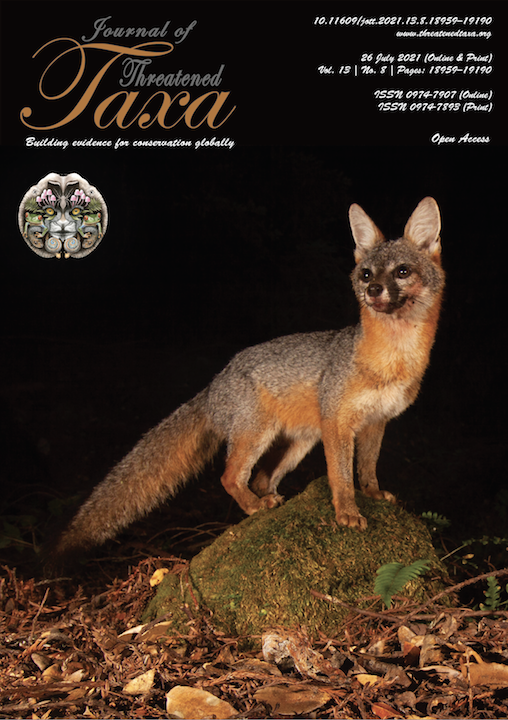Utilisation of honey trap method to ensnare a dispersing sub-adult Bengal Tiger Panthera tigris tigris L. in a human dominated landscape
Main Article Content
Abstract
The need to conserve the tiger, an endangered species and avoid interactions with humans is among the main objectives of forest management of tiger reserves in India. The objective of the study is show that male tigers can be trapped by pheromones in urine and feces of tigress for subsequent translocation. A sub-adult male tiger strayed out of Sariska Tiger Reserve into the human dominated areas to look for territory. Attempts to tranquilize the tiger failed due to dense vegetation. Then the urine and feces of a captive tigress was used to trail the tiger, capture him, and release him into his natal area thereby avoiding incidents with humans. Tracking data indicated that the tiger had settled in the northern area part of Sariska and subsequently sired seven cubs with two tigresses.
Article Details

This work is licensed under a Creative Commons Attribution 4.0 International License.
Authors own the copyright to the articles published in JoTT. This is indicated explicitly in each publication. The authors grant permission to the publisher Wildlife Information Liaison Development (WILD) Society to publish the article in the Journal of Threatened Taxa. The authors recognize WILD as the original publisher, and to sell hard copies of the Journal and article to any buyer. JoTT is registered under the Creative Commons Attribution 4.0 International License (CC BY), which allows authors to retain copyright ownership. Under this license the authors allow anyone to download, cite, use the data, modify, reprint, copy and distribute provided the authors and source of publication are credited through appropriate citations (e.g., Son et al. (2016). Bats (Mammalia: Chiroptera) of the southeastern Truong Son Mountains, Quang Ngai Province, Vietnam. Journal of Threatened Taxa 8(7): 8953–8969. https://doi.org/10.11609/jott.2785.8.7.8953-8969). Users of the data do not require specific permission from the authors or the publisher.
References
Champion, H.G. & H.K. Seth (1968). A revised survey of the forest type of India. Government of India Press, Delhi, 404 pp.
Goodrich, J.M., D.G. Miquelle, E.N. Smirnov, L.L Kerley, H.B. Quigley & M.G. Hornocker (2010). Spatial structure of Amur (Siberian) Tigers (Panthera tigris altaica) on Sikhote–Alin Biosphere Zapovednik, Russia. Journal of Mammalogy 91(3): 737–748.
Karanth, K.U. (2001). The Way of theTtiger: National History and Conservation of the Endangered Big Cat. Hyderabad, India, 132pp.
Rodgers, W.A. & H.S. Panwar (1988). Planning wildlife protected area network in India Vol. I & II Wildlife Institute of Dehradun.
Sankar, K., Q. Qureshi, P. Nigam, P.K. Malik, P.R. Sinha, R.N. Mehrotra, R. Gopal, S. Bhattacharjee, K. Mondal & S. Gupta (2010). Monitoring of reintroduced tigers in Sariska Tiger Reserve, western India: preliminary findings on home range, prey selection and food habits. Journal of Tropical Conservation Science 3(3): 301–318.

